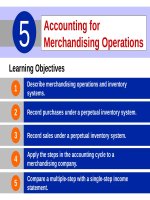Accounting principles 12th willey kieso chapter 12
Bạn đang xem bản rút gọn của tài liệu. Xem và tải ngay bản đầy đủ của tài liệu tại đây (1.69 MB, 70 trang )
12
Accounting for Partnerships
Learning Objectives
12-1
1
Discuss and account for the formation of a partnership.
2
Explain how to account for net income or net loss of a partnership.
3
Explain how to account for the liquidation of a partnership.
LEARNING
OBJECTIVE
1
Discuss and account for the formation of a partnership.
Partnership, an association of two or more persons to carry on as co-owners of a business for
profit.
Type of Business:
12-2
Small retail, service, or manufacturing companies.
Accountants, lawyers, and doctors.
LO 1
Characteristics of Partnerships
ASSOCIATION OF INDIVIDUALS
Legal entity.
Accounting entity.
Net income not taxed as a separate entity.
MUTUAL AGENCY
Act of any partner is binding on all other partners, so long as the act appears to be appropriate for the
partnership.
12-3
LO 1
Characteristics of Partnerships
LIMITED LIFE
Dissolution occurs whenever a partner withdraws or a new partner is admitted.
Dissolution does not mean the business ends.
UNLIMITED LIABILITY
12-4
Each partner is personally and individually liable for all partnership liabilities.
LO 1
Characteristics of Partnerships
CO-OWNERSHIP OF PROPERTY
Each partner has a claim on total assets.
This claim does not attach to specific assets.
All net income or net loss is shared equally by the partners, unless otherwise stated in the
partnership agreement.
12-5
LO 1
Characteristics of Partnerships
Question
All of the following are characteristics of partnerships except:
12-6
a.
co-ownership of property.
b.
mutual agency.
c.
limited life.
d.
limited liability.
LO 1
Organizations with Partnerships Characteristics
Special forms of business organizations are often used to provide protection from unlimited liability.
Special partnership forms are:
Limited Partnerships,
Limited Liability Partnerships, and
Helpful
Helpful Hint
Hint In
Inan
anLLP,
LLP,all
all
partners
partnershave
havelimited
limited
12-7
liability.
liability.There
There are
areno
no
Limited Liability Companies.
general
general partners.
partners.
LO 1
Organizations with Partnerships Characteristics
Regular
Regular Partnership
Partnership
Major Advantages
Major Disadvantages
Simple and inexpensive to create and
operate.
12-8
Owners (partners) personally liable for
business debts.
LO 1
Organizations with Partnerships Characteristics
Major Advantages
“Ltd.,”
“Ltd.,” or
or “LP”
“LP”
Limited partners have limited personal
liability for business debts as long as they do
not participate in management.
General partners can raise cash without
Major Disadvantages
business debts.
involving outside investors in management of
business.
General partners personally liable for
More expensive to create than regular
partnership.
Suitable for companies that invest in real
estate.
12-9
LO 1
Organizations with Partnerships Characteristics
Major Advantages
“LLP”
“LLP”
Mostly of interest to partners in old-line
professions such as law, medicine, and
accounting.
Owners (partners) are not personally liable
Major Disadvantages
Partners remain personally liable for many
types of obligations owed to business
for the malpractice of other partners.
creditors, lenders, and landlords.
12-10
Often limited to a short list of professions.
LO 1
Organizations with Partnerships Characteristics
Major Advantages
“LLC”
“LLC”
Owners have limited personal liability for
business debts even if they participate in
management.
Major Disadvantages
More expensive to create than regular
partnership.
12-11
LO 1
Partnership Form of Organization
Question
Under which of the following business organization forms do limited partners have little, if any, active
role in the management of the business?
12-12
a.
Limited liability partnership.
b.
Limited partnership.
c.
Limited liability companies.
d.
None of the above.
LO 1
Accounting Across the Organization
Limited Liability Companies Gain in Popularity
The proprietorship form of business organization is still the most popular, followed by the corporate form. But
whenever a group of individuals wants to form a partnership, the limited liability company is usually the
popular choice. One other form of business organization is a subchapter S corporation. A subchapter S
corporation has many of the characteristics of a partnership—especially taxation as a partnership—but it is
losing its popularity. The reason: It involves more paperwork and expense than a limited liability company,
which in most cases offers similar advantages.
12-13
LO 1
Advantages and Disadvantages of Partnerships
Illustration 12-2
Advantages
•
Combining skills and resources of two or more individuals
•
Ease of formation
•
Freedom from governmental regulations and restrictions
•
Ease of decision-making
Disadvantages
12-14
•
Mutual agency
•
Limited life
•
Unlimited liability
LO 1
Partnership Agreement
Should specify relationships among the partners:
12-15
1.
Names and capital contributions of partners.
2.
Rights and duties of partners.
3.
Basis for sharing net income or net loss.
4.
Provision for withdrawals of assets.
5.
Procedures for submitting disputes to arbitration.
6.
Procedures for the withdrawal or addition of a partner.
7.
Rights and duties of surviving partners in the event of a partner’s death.
LO 1
Accounting Across the Organization
Dividing Up the Pie
What should you do when you and your business partner disagree to the point where you are no longer on speaking terms? Given
how heated business situations can get, this is not an unusual occurrence. Unfortunately, in many instances the partners do
everything they can to undermine each other, eventually destroying the business. In some cases, people even steal from the
partnership because they either feel that they “deserve it” or they assume that the other partners are stealing from them. It would
be much better to follow the example of Jennifer Appel and her partner. They found that after opening a successful bakery and
writing a cookbook, they couldn’t agree on how the business should be run. The other partner bought out Ms. Appel’s share of the
business. Ms. Appel went on to start her own style of bakery, which she ultimately franchised.
Source: Paulette Thomas, “As Partnership Sours, Parting Is Sweet,” Wall Street Journal, (July 6, 2004), p. A20.
12-16
LO 1
Accounting for a Partnership Formation
Illustration: A. Rolfe and T. Shea combine their proprietorships to start a partnership named U.S. Software.
Rolfe and Shea have the following assets prior to the formation of the partnership.
Illustration 12-3
Book and fair values of assets
invested
12-17
LO 1
Accounting for a Partnership Formation
Illustration: Prepare the entry to record the investment of A. Rolfe.
Cash
8,000
Equipment
4,000
A. Rolfe, Capital
12,000
Prepare the entry to record the investment of T. Shea.
Cash
9,000
Accounts Receivable
4,000
Allowance for Doubtful Accounts 1,000
T. Shea, Capital
12-18
12,000
LO 1
Accounting for a Partnership Formation
Question
When a partner invests noncash assets in a partnership, the assets should be recorded at their:
12-19
a.
book value.
b.
carrying value.
c.
fair market value.
d.
original cost.
LO 1
DO IT!
1
Partnership Organization
Indicate whether each of the following statements is true or false.
False1. Partnerships have unlimited life. Corporations do not.
________
True2. Partners jointly own partnership assets. A partner’s claim on partnership assets does not attach to
________
specific assets.
________ 3. In a limited partnership, the general partners have unlimited liability.
True
________ 4. The members of a limited liability company have limited liability, like shareholders of a corporation, and
they are taxed like corporate shareholders.
False
________ 5. Because of mutual agency, the act of any partner is binding on all other partners.
True
12-20
LO 1
LEARNING
2
OBJECTIVE
Explain how to account for net income or net loss of a partnership.
Dividing Net Income or Net Loss
Partners equally share net income or net loss unless the partnership contract indicates
otherwise.
CLOSING ENTRIES:
12-21
Close all Revenue and Expense accounts to Income Summary.
Close Income Summary to each partner’s Capital account for his or her share of net income or loss.
Close each partners Drawing account to his or her respective Capital account.
LO 2
Dividing Net Income or Net Loss
INCOME RATIOS
Partnership agreement should specify the basis for sharing net income or net loss. Typical income
ratios:
12-22
Fixed ratio.
Ratio based on capital balances.
Salaries to partners and remainder on a fixed ratio.
Interest on partners’ capital balances and the remainder on a fixed ratio.
Salaries to partners, interest on partners’ capital, and the remainder on a fixed ratio.
LO 2
Dividing Net Income or Net Loss
Question
Which of the following statements is correct?
12-23
a.
Salaries to partners and interest on partners' capital are expenses of the partnership.
b.
Salaries to partners are an expense of the partnership but not interest on partners' capital.
c.
Interest on partners' capital are expenses of the partnership but not salaries to partners.
d.
Neither salaries to partners nor interest on partners' capital are expenses of the partnership.
LO 2
Dividing Net Income or Net Loss
Illustration: Sara King and Ray Lee are co-partners in the Kingslee Company. The partnership agreement
provides for: (1) salary allowances of $8,400 to King and $6,000 to Lee, (2) interest allowances of 10% on
capital balances at the beginning of the year, and (3) the remainder equally. Capital balances on January 1
were King $28,000, and Lee $24,000. In 2017, partnership net income is $22,000. The division of net income
is as follows.
Instructions
12-24
(a)
Prepare a schedule showing the distribution of net income.
(b)
Journalize the allocation of net income.
LO 2
Dividing Net Income or Net Loss
Illustration 12-5
12-25
LO 2









